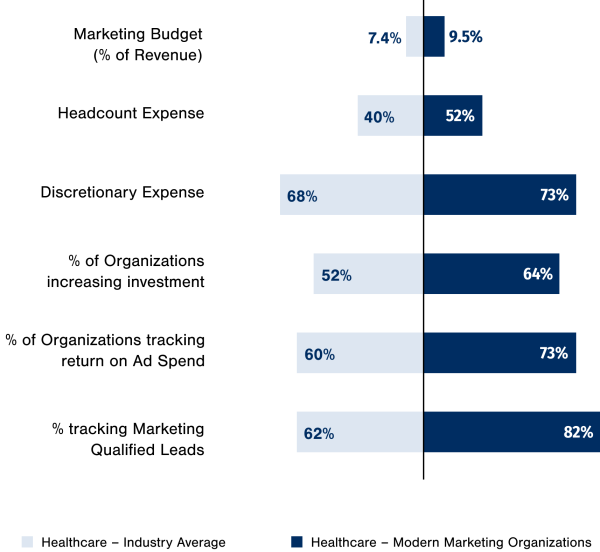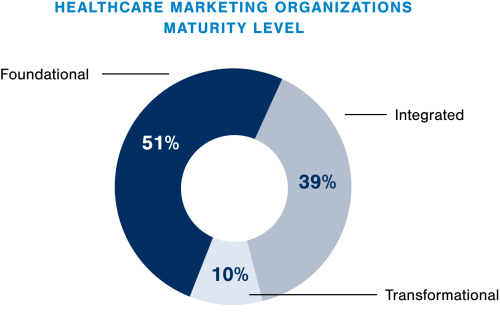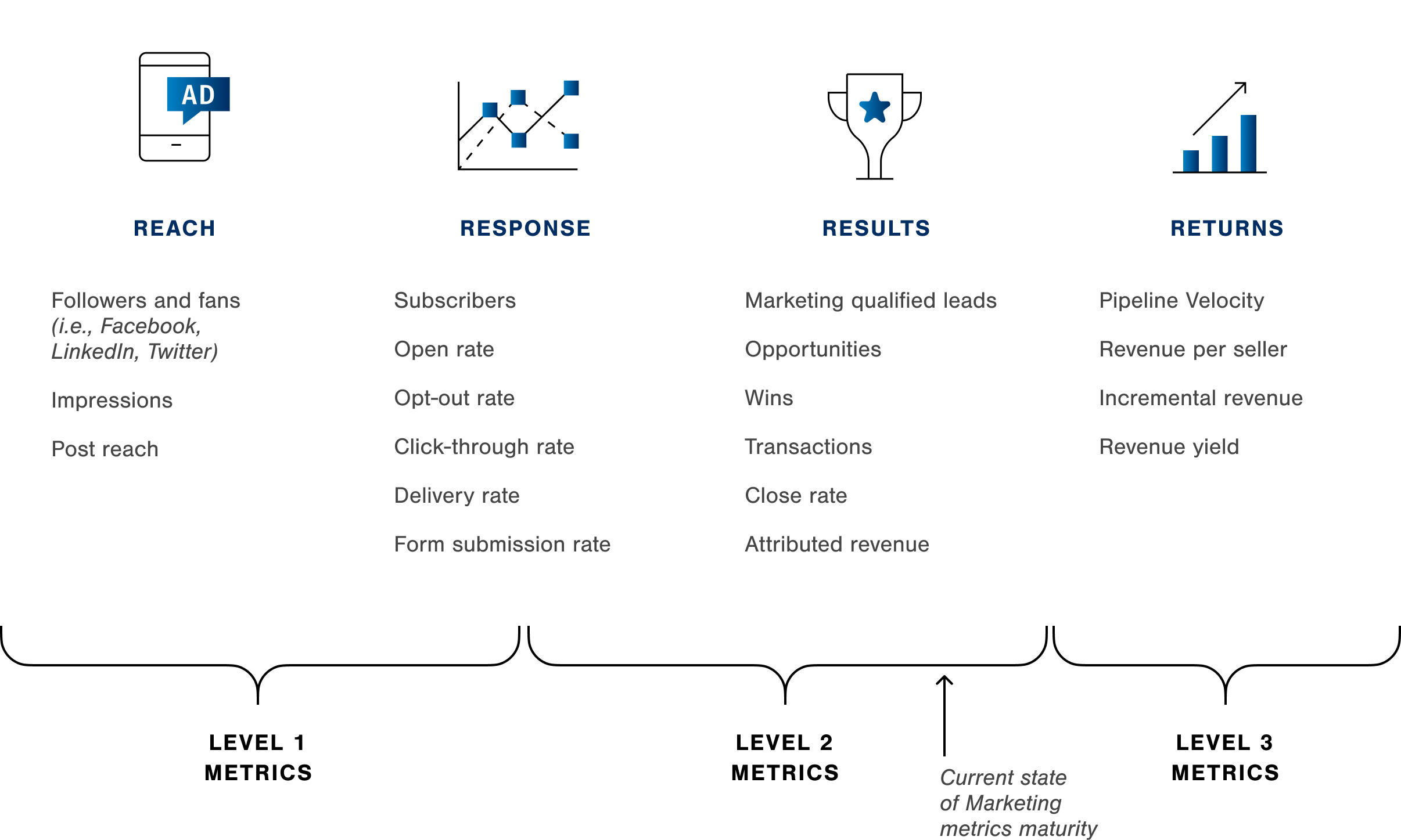Introduction
In today’s market, healthcare payers struggle to grow membership. Achieving strategic growth requires payers to focus on the initial enrollment period, a critical window of opportunity to convert and activate new members while retaining existing members. However, without target investments in a modern marketing organization, it is unlikely that healthcare payers will achieve their growth goals, resulting in a continued lag against market leaders.
The Modern Marketing Organization Generates Demand
Traditionally, healthcare payers relied on brand awareness to reach enrollment goals.
Brand awareness included both Corporate vs. Licensee marketing, which had different approaches to the same purpose. However, payers must also invest in demand generation to grow membership. A modern marketing organization is central to demand generation, balancing channel investments and mix to increase overall membership.
A Modern Marketing Model leverages enablement tools and specific job roles, coordinates with sales teams and designs work processes to generate demand. The marketing organization focuses on supporting traditional brand awareness and gaining customer attention pre-acquisition while creating strategies that improve the customer experience throughout their membership term. Finally, performance metrics and advanced data analytics serve to optimize the investment in the organization, revealing distinct opportunities for further engagement.
Modern marketing is relatively new for healthcare payers. The reluctance to adopt this approach has resulted in lagging investment and capabilities. For instance, Alexander Group’s Healthcare research revealed that over 55% of organizations studied expressed organizational misalignment and inefficiency, while only 10% could measure the return on their marketing investment.
The need for healthcare payers to play catch up on their marketing investments is apparent. Demand generation requires healthcare payers to target the right investments, implement new roles and strategies, and track the performance of marketing activities to achieve desired membership retention and growth.
In addition, Alexander Group’s research indicates that only 52% of healthcare companies are increasing their marketing investment, gaining effectiveness by leveraging data to target accounts, aligning with sales, developing lead generation processes and improving the customer experience. Increased investment correlates to positive results, as shown below:

Modern Marketing Organizational Design
The imperative for a modern marketing organization is clear and demonstrates a return on marketing investment and direct profitability impact to healthcare payers. First, investments focus on efforts that positively impact members’ customer experience. Second, this approach leverages organizational efficiencies across Marketing, Sales and Service, which optimize investments. Third, defining common data uses and advanced segmentation reveals specific opportunities to maximize marketing motions and desired results.
Getting started requires a holistic approach to ensure that investments, customer experience, operational efficiencies and data achieve the desired results. Essential elements for an effective Modern Marketing Model include:
Organizing the Ecosystem
Redefine organizational resources and processes. New job roles, responsibilities and playbooks will clarify motions and expectations.
Segmenting Customers/Members
Differentiate marketing and sales motions based on patient volume and talent needs, addressing acquisition and retention goals.
Channel Effectiveness
Identify specific channels that will deliver effective, impactful and seamless membership experiences that address the unique needs of each segment.
Data and Insights
Manage data as an asset, sharing information across organizational silos, focusing on driving member acquisition and retention.
Technology and Tools
Drive adoption and integration of enablement tools, including ongoing user training.

Foundational (51%) – Rely on single-dimension data and channels and use manual response-based metrics. They operate with independent marketing teams and lack coordination. They also experience a low level of technology adoption.
Integrated (39%) – Rely on 3-D dimension data and inbound-outbound channels and use outcome-based metrics with attributed revenue. They also operate with a shared vision and processes across teams and are increasing technology adoption.
Transformational (10%) – Optimize cross-ecosystem execution using multi-dimensional data and physical and digital channel interactions. They create incremental revenue, velocity and yield from customer outcomes.
No matter what level of maturity, healthcare payers must get started with modern marketing investments to accelerate demand generation. As the organization matures, focused investments increase organizational efficiencies and enhance competitive standing.
Performance Metrics Reflect ROI Effectiveness
As companies mature, they increasingly rely on metrics to improve their performance. However, our research indicates that, currently, healthcare executives cannot effectively measure the ROI of their marketing investment.
Specific challenges include:
- Inability to track funnel activity
- Data integrity issues
- Lack of insight between marketing campaign performance and ROI
Without a correlation between investment and marketing performance, achieving the primary goal of improving reach and response remains nearly impossible. Healthcare payers will continue to struggle with membership acquisition and retention without specific, outcome-based metrics.
Tracking marketing metrics to membership enrollment is essential to validate marketing success. Gauging the effectiveness of the modern marketing organization requires defined measurements and consistent review, ensuring the organization remains aligned with defined goals. Each metric reflects the success of a specific marketing initiative, campaign, or process. However, these measurements must reflect performance, be meaningful and be actionable.
Establishing the right metrics requires a proven project approach, starting with a Marketing Performance Diagnostic. Our work with leading healthcare payers focuses on optimizing marketing performance and accelerating ROI, including:
- Content Performance Analysis
- Marketing Campaign and Channel Contribution
- Marketing Lead Source and Win Rate Optimization
- Funnel Fallout Assessment
- Prospect and Account Coverage Analysis
- Marketing Diagnostic Findings and Recommendations
These marketing initiatives are common to most modern marketing organizations, but each company may have specific functions that reflect their demand generation goals. A comprehensive diagnostic approach targets and measures the resources required to optimize marketing performance and its impact on growth goals.

Benefits for Healthcare Payers
Demand generation, in addition to brand awareness, is a critical investment for healthcare payers. Each strategy requires specific motions that align with targeted growth strategies. By implementing modern marketing techniques, accelerating demand generation drives both member retention and new membership enrollments.
In addition, organizations will benefit from the following:
- Improved overall member enrollment profitability.
- Reduced customer acquisition costs.
- Improved member retention and recurring revenue streams
With growth imperatives at an all-time high, healthcare payers must optimize their demand generation investments to receive the competitive advantages that a Modern Marketing Model offers.
Demand Generation Expertise
Leading healthcare payers turn to Alexander Group because of our experience in the healthcare sector, expertise and proprietary benchmarks. We assist leading healthcare payers in designing marketing and sales transformation programs that align with corporate growth objectives. Using the proven Alexander Group Revenue Growth Model™, we design future-state organizations that support ongoing revenue growth. Contact us to learn more.
Healthcare Practice
Marketing Demand Generation Performance & Investment Study
Upcoming Events
About Alexander Group
Alexander Group understands your revenue growth challenges. Since 1985, we’ve served more than 3,000 companies across the globe. This experience gives us not only a highly sophisticated set of best practices to grow revenue—we also have a rich repository of unique industry data that informs all our recommendations. Aligning product, marketing, operations and finance efforts behind a successful sales organization takes insight and hard work. We help the world’s leading organizations build the right revenue vision, transform their organizations and deliver results.
